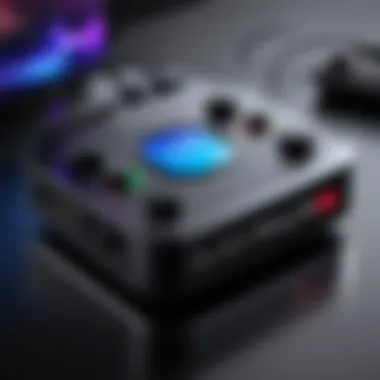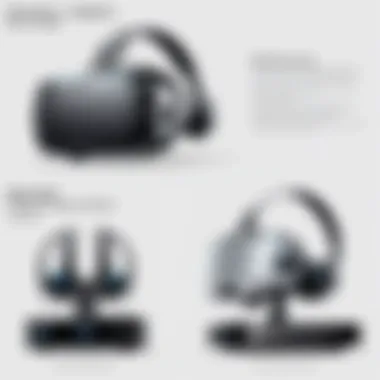Exploring Valve Index Base Station: Functionality & Impact


Intro
In the realm of virtual reality, where immersion is king, the significance of the Valve Index Base Station cannot be overstated. This piece of hardware forms the backbone of a seamless VR experience. For gamers and IT professionals alike, understanding such a critical component can mean the difference between a good experience and a phenomenal one. The Valve Index Base Station serves not just as a tracking device, but as an influential part of the broader ecosystem that enhances user engagement and precision in virtual environments.
As we explore this pivotal device, we will unfold its design, key features, and the intricate technologies that power it. We’ll dissect its performance in direct comparison with other products in the market. The aim here is simple: equip you with knowledge, enabling you to make informed decisions. For those who strive for the utmost in VR realism, this is a journey worth taking.
Prologue to the Valve Index Base Station
The Valve Index Base Station plays a pivotal role in the immersive world of virtual reality. It’s not merely an accessory; it’s the backbone of a rich, engaging VR experience. Understanding its functionality provides insights into how this device enhances precision and interaction in virtual environments. This section delves into the core elements of the Valve Index Base Station, shedding light on its design, functionality, and the effects it has on tracking capabilities.
Overview of Virtual Reality Components
Virtual reality is akin to a staged performance where technology serves as the stage and the players are the users. Here, several components work harmoniously to create an all-encompassing simulation. The Valve Index Base Station serves as a vital piece of this intricate machinery. At its core, one can think of it as the conductor in an orchestra—keeping everything in sync. Among the essential parts of a VR setup, you can find:
- VR Headset: The visual perceiver that transports users into the virtual realm. This is where users experience graphics, sounds, and the immersive world.
- Controllers: These devices allow users to manipulate the VR environment, injecting realism and interactivity into their experience.
- Tracking System: The unsung hero; it ensures accurate positional and motion data, preventing the experience from being marred by lag or imprecision.
Without these components correctly working together, even the most sophisticated games would seem flat and uninviting, much like a book without any words.
Importance of Tracking Systems in VR
At the heart of virtual reality's allure lies its ability to track user movements with uncanny precision. This tracking is essential for creating a seamless and believable experience. The Valve Index Base Station offers a superior tracking system that establishes a dynamic space for users to navigate. Some key points illustrating its importance include:
- Real-Time Feedback: Users move and interact within their environment, and high-quality tracking ensures that their actions translate into real-time responses.
- Enhanced Immersion: When head and body movements are accurately followed, the user feels truly present in the virtual world. A poor tracking system can break this immersion, turning excitement into frustration.
- Social Interaction: For multiplayer experiences, precise tracking fosters communication and connection. Imagine playing with friends but having lags causing awkward movements; it wouldn't be the same.
"The ability to move freely and see yourself represented accurately in VR changes how players engage with the world around them."
In summary, not only does the Valve Index Base Station support tracking, but it also uplifts the entire VR experience to a new level. Understanding these elements and how they fit together provides a clearer picture of what makes the Valve Index Base Station a crucial component of modern virtual reality.
Technical Specifications
The Valve Index Base Station represents the backbone of an immersive virtual reality setup. Understanding its technical specifications is crucial for enthusiasts, gamers, and IT professionals alike, as these elements directly influence user experience and overall system performance. The details behind its design, functionality, and communication capabilities ensure that users can fully leverage the potential of their VR environments.
Design and Build Quality
When evaluating the Valve Index Base Station, one cannot overlook the importance of its design and build quality. The base station is engineered to be both functional and aesthetically pleasing. Its sleek, minimalist design allows it to blend into almost any environment while being robust enough to withstand regular usage. The sturdy casing not only protects the delicate internal components but also helps in maintaining constant functionality over time.
One handy feature is its adjustable mount. Users can easily position the base stations on the wall or other surfaces, providing versatility in setup. The unit’s ability to tilt and swivel improves tracking accuracy and ensures that it can be fine-tuned based on the specific layout of the space, thus allowing for greater personalization of the VR experience.
Tracking Range and Accuracy
A standout attribute of the Valve Index Base Station is its impressive tracking range and accuracy. Utilizing Valves' tracking technology, the system can achieve a tracking volume of up to 10m x 10m, offering users considerable room to move freely without losing tracking fidelity. This is especially beneficial for multiplayer setups where players may move around a large area.
Accurate tracking is further enhanced by the Base Station’s ability to use multiple units together, thus creating a larger play area. This capability ensures minimal obstruction during gameplay, even when players move speedily or change directions unexpectedly. By maintaining precise positional tracking, users can dive deep into their virtual environments, leading to a more engaging and immersive experience.
Audio and Communication Features


In the realm of virtual reality, audio quality is just as significant as visual fidelity, and the Valve Index Base Station doesn’t disappoint. It integrates advanced communication features that facilitate seamless interaction between the headset and peripheral devices, ensuring that any audio output remains clear and immersive. High-fidelity audio enhances user experience, whether it's the subtle sound of virtual footsteps or the booming effects of an intense game.
The Base Station employs low-latency communication protocols, ensuring that there is little to no delay in audio transmission. This responsiveness is critical, especially in competitive gaming environments where split-second reactions can determine success or failure. Additionally, its ability to connect and support various audio devices enriches the overall experience, making players feel as if they are part of the virtual world.
The combination of accurate tracking and high-quality audio makes the Valve Index Base Station a pivotal component in virtual reality setups.
By laying out these technical specifications, it's evident that the Valve Index Base Station is designed not just for function but also to enhance the overall VR experience. Each feature and element is a testament to the thoughtful engineering behind this essential device.
Setup Process
Setting up the Valve Index Base Station is not merely a step; it is the foundation upon which your virtual reality experience is built. The meticulous attention to detail during this process can significantly influence the quality of immersion and interaction you’ll enjoy. In this segment, we’ll break down the necessary hardware and software, delve into the placement and configuration essentials, and tackle common troubleshooting issues you might encounter.
Required Hardware and Software
To get the ball rolling, ensure you have all the required components. First off, the Valve Index Base Station needs to be paired with the Valve Index Headset, naturally. Beyond that, here’s a closer look at the key hardware and software components involved:
- Hardware Requirements:
- Software Requirements:
- Valve Index Base Stations: Usually, two are necessary for optimal coverage.
- Valve Index Headset: The main interface for the VR experience.
- PC Specifications: A robust computer capable of meeting the following specifications can run VR smoothly:
- Windows 10 or newer.
- Intel i5-4590 or better; AMD Ryzen 5 1500X or greater.
- NVIDIA GeForce GTX 970 / AMD RX480 or superior.
- 8GB+ RAM.
- Steam: The platform that manages titles and VR support.
- SteamVR: This piece of software is essential; it enables the experience and connects your VR hardware.
Besides these specifics, ensure your operating system and drivers are updated to keep everything running smoothly. It’s crucial to keep your ‘tech’ in check before diving into the digital world.
Placement and Configuration Tips
Once you've gathered your gear, the next step involves a bit of spatial planning. Placement of your base stations can make or break the tracking quality. Here are some tips:
- Height and Angles: Mount the base stations approximately 6.5 to 7.5 feet off the ground. Tilt them slightly downwards by about 30 degrees to maximize tracking.
- Diagonal Positioning: Ideally, position the stations diagonally from each other in your play area. The greater the distance and the less obstructions, the better the tracking.
- Clear Line of Sight: Ensure there are no obstacles between the headset and the base stations. Objects like furniture, even plants, can interfere with tracking.
"The real magic of VR lies not just in the technology, but in how well you set it up."
- Test Coverage: After positioning, run the setup process through SteamVR to ensure optimal coverage. Moving around your designated play area will help in identifying any blind spots.
Troubleshooting Setup Issues
Even with the best intentions, issues may arise. Knowing how to troubleshoot can save you time and headaches.
- No Tracking Detected: This often means a base station isn’t correctly configured or powered. Double-check the power source and reboot both the base stations and your PC.
- Laggy Response: If there is a noticeable lag, consider reducing the play area size. A more confined space can sometimes improve the tracking responsiveness.
- Signal Interference: Check for any potential Wi-Fi networks or other electronic devices that might interfere with the base stations. Switching off other devices can sometimes improve performance.
By taking these steps and addressing potential hiccups as they arise, you can optimize your Valve Index setup and pave the way for an engaging VR adventure. Setting up isn't just about hardware; it's an investment in the quality of your gaming and exploration experiences.
Comparative Analysis


The comparative analysis section serves as an illuminating lens through which we can examine the Valve Index Base Station in relation to its peers within the virtual reality ecosystem. In an industry where advancements happen at breakneck speed, understanding the unique attributes and limitations of this technology is crucial for both enthusiasts and professionals alike. By juxtaposing the Valve Index with other VR tracking systems, we bring to light its distinctive strengths and weaknesses. This not only aids in making informed purchasing decisions but also sheds light on the evolution of VR technologies.
When assessing the merits of the Valve Index Base Station, several specific elements come into play:
- Tracking Precision: An integral aspect of any VR setup, tracking precision can make or break the immersive experience. Comparing the Index's performance against competitors elucidates its standing in accuracy and responsiveness.
- Setup Convenience: The ease of setup is often overlooked but can be a game-changer for many users. Analyzing the complexity of installation against other systems provides insight into user-friendliness.
- Compatibility: As the VR market expands, compatibility with various headsets and controllers becomes a crucial factor. Understanding the Valve Index's compatibility range helps users weigh their options better.
- Cost vs. Performance: The price point often dictates whether technology is accessible or remains a luxury. Evaluating the cost-to-performance ratio provides a clearer picture of the investment needed for superior performance.
This deep dive into comparative analysis enriches our understanding, keeping the conversation grounded in practicality while also painting a broader picture of the VR landscape.
Valve Index vs. Other VR Tracking Systems
The Valve Index Base Station holds its own against other tracking systems, which include Oculus /Meta Quest, HTC Vive, and more. Each system features unique tracking capabilities and experiences, impacting how users interact within their virtual spaces.
- Oculus Quest: Unlike the Valve Index, which relies on external base stations for tracking, the Oculus Quest operates using built-in cameras for inside-out tracking. This provides convenience but may introduce limitations in tracking precision and range.
- HTC Vive: The Vive, with its Lighthouse tracking system, offers robust tracking similar to the Valve Index. However, users often cite the Index as having superior build quality and ease of use.
- Mixed Reality Headsets: Headsets like the Windows Mixed Reality use a different approach, relying on various sensors for tracking. While these are quite user-friendly, they often struggle with the same level of accuracy seen in the Valve Index base stations.
Ultimately, the Valve Index impressively merges accuracy and usability, often standing out in clarity and tracking stability.
Pros and Cons of the Valve Index Base Station
When it comes to the Valve Index Base Station, there are several pros and cons that potential buyers should weigh carefully. This hardware carries a distinct set of advantages that enhance the user experience, but no product is without its drawbacks.
Pros:
- Exceptional Tracking Accuracy: Many users rave about the pinpoint accuracy and extremely low latency, which elevate the overall immersive experience.
- Wide Tracking Range: With a tracking range that can cover large spaces, users can move freely without losing tracking integrity, making it ideal for room-scale VR.
- Robust Build Quality: The overall design is sturdy and well thought out, enhancing longevity and reducing wear over time.
Cons:
- Setup Complexity: Some users report a steep learning curve during the setup process, especially when trying to achieve the optimal placement for base stations.
- Cost Consideration: The Valve Index, including its base stations, is generally more pricey compared to some competitors, which might deter budget-conscious buyers.
- Space Requirements: To get the most out of the Index, a fair amount of space is necessary, which can be a limiting factor for users with smaller living areas.
By weighing both the pros and cons, enthusiasts can make well-rounded decisions about whether the Valve Index Base Station aligns with their VR gaming preferences.
User Experience
When it comes to virtual reality, User Experience is paramount. For enthusiasts and gamers alike, the interaction between hardware and gameplay defines the immersive quality of VR. The Valve Index Base Station plays a critical role in shaping this experience, extending beyond mere functionality to how users perceive their interactions within digital environments.
Feedback from Early Adopters
Early adopters of the Valve Index Base Station have shared a variety of insights. Many users confirm that the setup is relatively straightforward, though it requires good placement of the base stations for optimal performance. Strings of positive feedback frequently highlight the precision tracking capabilities, allowing for smooth movements without noticeable lag. Users often reference the Base Station’s ability to handle large play areas, making it a preferred choice for those who enjoy full-body engagement in games like Beat Saber or Half-Life: Alyx.
However, some have noted the challenges with line-of-sight obstructions. If placed in corners or behind objects, users can encounter tracking interruptions. This has led to discussions on platforms like Reddit, where players post their experiences and tips for optimal placement. While the shortcomings are mentioned, they are often coupled with solutions, demonstrating a community eager to enhance the overall User Experience.
Impact on Gameplay and Interactivity
The Valve Index Base Station doesn’t just provide positioning; it reshapes the core of gameplay. With its superior tracking accuracy, users experience a level of interaction that feels almost lifelike. This is particularly crucial in competitive gaming where split-second decisions can make or break the experience. Users of Boneworks have remarked on how the realistic physics engine works seamlessly with the precise tracking of the base stations, allowing players to manipulate game elements in ways previously thought impossible in VR.
Moreover, the interactivity facilitated by the Base Station enriches immersion. Gamers find themselves not just playing the game, but truly engaging with it. With the ability to move freely in a tracked space, players report a profound impact on their emotional engagement with the game narrative. It's not just about seeing the game world but truly being in it. This deep level of connectivity is key in establishing VR as a compelling platform for storytelling and interactive experiences.


Long-Term Usability and Maintenance
When considering long-term usability, the Valve Index Base Station showcases some strong points. Generally speaking, it has a solid build quality and reliability, standing up to the rigors of long gaming sessions. Users appreciate that even after extensive use, the stations maintain consistent tracking performance, which bodes well for its longevity in a user’s setup.
Yet, no product is withoutits flaws. Regular maintenance is necessary to ensure optimal performance. Dust accumulation on the lenses can sometimes hinder tracking, making occasional cleaning and checks essential. Some users even suggest scheduling regular maintenance sessions similar to one might do with a PC build. Engaging with the Valve Index community on forums like Facebook can reveal tips on caring for the base stations — from cleaning hacks to placement guides.
In summation, User Experience with the Valve Index Base Station encapsulates a journey characterized by passionate feedback from users, enhanced gameplay interactions, and the importance of maintenance practices. The base station doesn't just connect devices; it connects players to immersive worlds, making the investment worthwhile for tech enthusiasts and gamers alike.
Future Developments
The realm of virtual reality is ever-evolving, and the Valve Index Base Station is no exception. Understanding future developments is crucial for users and enthusiasts who want to stay ahead in this fast-paced technology landscape. This section sheds light on key elements that not only anticipate potential advancements but also highlight the benefits and considerations in the context of improving user experience and capability within VR environments.
Anticipated Software Updates
Software updates play a significant role in refining the functionality of VR hardware. For the Valve Index Base Station, these updates can address various aspects, from performance optimizations to new features that enhance tracking precision.
- Improved Tracking Algorithms: One of the most promising prospects includes the enhancement of tracking algorithms. With refined algorithms, users can expect better precision in tracking movements, which is critical in high-paced gaming scenarios.
- Compatibility with New Games: As more developers tap into VR gaming, updated software will be necessary to ensure compatibility with newer titles. By providing seamless interactions within VR environments, the updates would minimize any lag or disconnect.
- User Interface Enhancements: Software updates are also poised to introduce a more intuitive user interface. A user-friendly interface is not just about aesthetics; it allows users, regardless of technical expertise, to navigate settings and configurations with ease.
"In the realms of technology, the ability to adapt through software updates can often be the key differentiator between successful hardware and those that fade into oblivion."
Potential Hardware Improvements
While software upgrades are important, the potential for hardware improvements often grabs the spotlight. A few notable possibilities for the Valve Index Base Station’s hardware include:
- Increased Tracking Performance: There’s room for elevating the tracking performance through improved sensors. Enhanced sensors can help expand the tracking range and reduce blind spots, which is a game-changer for VR gamers seeking a completely immersive experience.
- Design Innovations: With advancements in design, future iterations may bring about a sleeker, more elegant form factor that complements modern gaming setups. This not only elevates aesthetic appeal but may also improve functional aspects such as thermal management.
- More Robust Communication Protocols: Limiting the potential for interference can significantly elevate the user experience. Improving the communication protocols, aiming for a higher frequency band, could minimize latency and optimize overall performance.
- Power Efficiency Improvements: Hardware that demands less power while delivering similar or improved performance has significant long-term benefits. Such improvements would enhance the sustainability aspect of using these devices.
End
The Valve Index Base Station represents a pivotal aspect of the virtual reality experience, providing the foundational infrastructure for tracking and interaction. This conclusion serves not merely as an end but as a key summarization of its significance, benefits, and various considerations that users and developers may take into account.
Summarizing Key Insights
First and foremost, the Valve Index Base Station employs a captivating array of technologies that cater to both developers and users waiting to engage fully in virtual realms. Its specifications, such as impressive tracking ranges and superior accuracy, place it at the forefront of VR tracking systems. Furthermore, insights gleaned from early adopters exemplify real-world applications, highlighting how precision tracking can profoundly change interaction dynamics in gaming and simulation.
- Enhanced Tracking: Users benefit from outstanding positional tracking, making experiences feel incredibly immersive.
- User Feedback: Surveys reveal that players appreciate the seamless setup process, underscoring the importance of accessibility in VR technology.
- Future Proofing: Updates and improvements are on the horizon, ensuring that early investments continue to yield benefits.
Final Thoughts on the Valve Index Base Station
In summation, it's clear that the Valve Index Base Station is not just a piece of hardware; it's a gateway to advanced virtual experiences. When considering its features in tandem with user testimonies and future developments, one can see its full impact. The thoughtful design and operational integrity instill confidence for users looking to enhance their virtual reality experience.
"The Valve Index Base Station does not merely track your movements; it transforms your virtual existence, creating a bridge between reality and imagination."
For both tech aficionados and casual gamers alike, investing in a Valve Index Base Station proves to be an insightful decision. As you step into virtual worlds, let the technology within this base station guide your journey.
Ultimately, embracing advancements like the Valve Index Base Station paves the way for future explorations in VR, opening doors to rich, creative potentials yet to be discovered.
Cited Works and Additional Reading
To truly appreciate the Valve Index Base Station and its contributions to virtual reality, one must delve beyond the surface. Here’s a list of works that can provide a greater understanding:
- Official Documentation from Valve: This often contains the most accurate and detailed breakdown of the hardware's specifications and capabilities. Access valve's website for the latest manuals and user guides.
- Technical Reviews on Tech Magazines: Resources like TechRadar or IGN frequently publish reviews that analyze the performance and user experience of VR devices, including the Valve Index Base Station, comparing it to competitors.
- Forums and Community Discussions: Platforms like Reddit hold valuable discussions regarding troubles users encounter. Engaging with community feedback can shed light on user experiences that formal reviews might miss.
- YouTube Review Channels: Influencers or tech enthusiasts often provide walkthroughs and real-world usage scenarios, offering perspectives that written materials may not convey.
- Academic Journals on VR Technology: For a more scholarly insight, looking into journals focused on technology and human-computer interaction may be beneficial, particularly for those interested in the impacts heavy VR usage has on users.
When researching, cross-referencing these materials can yield a well-rounded comprehension of how the Valve Index Base Station fits into the broader VR ecosystem. Utilizing noted sources ensures that the final interpretation has a robust foundation, while personal insights shared through community platforms only elevate the conversation further.







